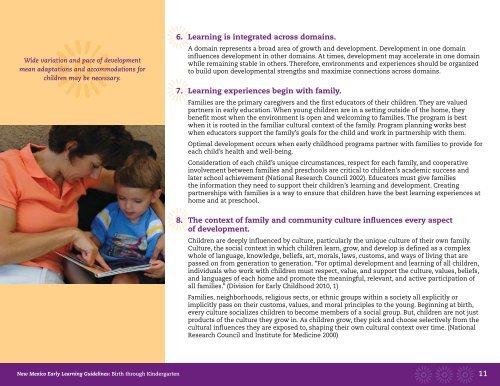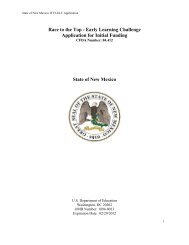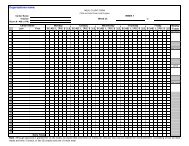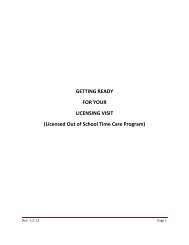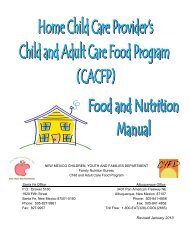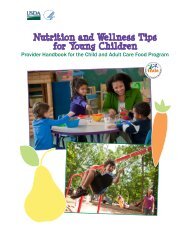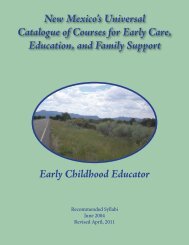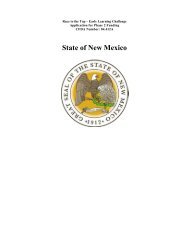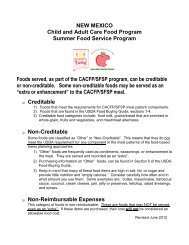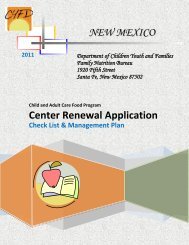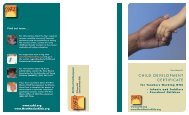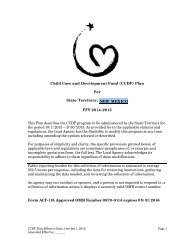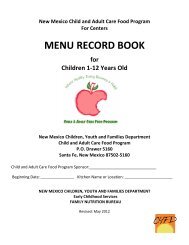Early Learning Guidelines - New Mexico Kids
Early Learning Guidelines - New Mexico Kids
Early Learning Guidelines - New Mexico Kids
Create successful ePaper yourself
Turn your PDF publications into a flip-book with our unique Google optimized e-Paper software.
<strong>New</strong> <strong>Mexico</strong> <strong>Early</strong> <strong>Learning</strong> <strong>Guidelines</strong>: Birth through Kindergarten 11<br />
444<br />
4<br />
Wide variation and pace of development<br />
mean adaptations and accommodations for<br />
children may be necessary.<br />
46. <strong>Learning</strong> is integrated across domains.<br />
A domain represents a broad area of growth and development. Development in one domain<br />
influences development in other domains. At times, development may accelerate in one domain<br />
while remaining stable in others. Therefore, environments and experiences should be organized<br />
to build upon developmental strengths and maximize connections across domains.<br />
47. <strong>Learning</strong> experiences begin with family.<br />
4<br />
Families are the primary caregivers and the first educators of their children. They are valued<br />
partners in early education. When young children are in a setting outside of the home, they<br />
benefit most when the environment is open and welcoming to families. The program is best<br />
when it is rooted in the familiar cultural context of the family. Program planning works best<br />
when educators support the family’s goals for the child and work in partnership with them.<br />
Optimal development occurs when early childhood programs partner with families to provide for<br />
each child’s health and well-being.<br />
Consideration of each child’s unique circumstances, respect for each family, and cooperative<br />
involvement between families and preschools are critical to children’s academic success and<br />
later school achievement (National Research Council 2002). Educators must give families<br />
the information they need to support their children’s learning and development. Creating<br />
partnerships with families is a way to ensure that children have the best learning experiences at<br />
home and at preschool.<br />
8. The context of family and community culture influences every aspect<br />
of development.<br />
Children are deeply influenced by culture, particularly the unique culture of their own family.<br />
Culture, the social context in which children learn, grow, and develop is defined as a complex<br />
whole of language, knowledge, beliefs, art, morals, laws, customs, and ways of living that are<br />
passed on from generation to generation. “For optimal development and learning of all children,<br />
individuals who work with children must respect, value, and support the culture, values, beliefs,<br />
and languages of each home and promote the meaningful, relevant, and active participation of<br />
all families.” (Division for <strong>Early</strong> Childhood 2010, 1)<br />
Families, neighborhoods, religious sects, or ethnic groups within a society all explicitly or<br />
implicitly pass on their customs, values, and moral principles to the young. Beginning at birth,<br />
every culture socializes children to become members of a social group. But, children are not just<br />
products of the culture they grow in. As children grow, they pick and choose selectively from the<br />
cultural influences they are exposed to, shaping their own cultural context over time. (National<br />
Research Council and Institute for Medicine 2000)


